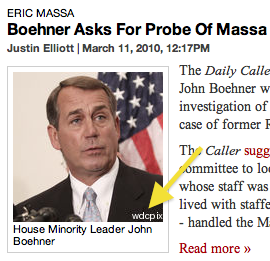
Lauren Victoria Burke’s strategy for success in the world of political photography is simple: undercut the Associated Press.
Burke runs a one-woman photography wire service in Washington, D.C. called WDCPIX that allows monthly subscribers to download as many of the hundreds of political photos available as they want. Her shots rival those of staff photographers working on the Hill; she typically covers congressional hearings and major public events in the city. She doesn’t guarantee specific event coverage, but does take requests and tries to accommodate her customers.
As a solo roving photographer in one of the world’s most photographed cities, she’s been able to build a business by targeting clients with budgets that won’t allow big costs for photography. About 25 to 30 of her clients are regulars; most pay a flat $260 monthly fee, although some have special arrangements. Subscribers include sites like Talking Points Memo and The Washington Independent; I became familiar with WDCPIX when I worked at both.
“Basically what you want to do is…create a business model that can undercut the bigger sites,” Burke told me. “There are a lot of news entities out there that can’t afford Associated Press or Getty or any of those guys. So you’re trying to create an environment where the smaller news entities out there, particularly with all these blogs around, they can subscribe to WDCPIX and make it very straightforward.”
For anyone familiar with the story of iStockphoto, the possibility of disruption in the photo business is nothing new. And while WDCPIX isn’t a breakout smash at iStockphoto’s scale, it shares a shift in the basic economics of the industry.
When Burke started out as an independent — she spent time at USA Today and the AP, among others — her focus was on bigger clients like C-SPAN and ABC News. She still does regular work for larger outlets, along with occasional clients in the nonprofit and advocacy sectors, like Defenders of Wildlife, and a few corporate clients like FedEx and Starbucks. (“A lot of times people are doing an annual report or they’re doing a brochure or they’re doing a website and they want to brighten it up with some photos,” she said.)

The business side
Burke runs every aspect of her business, including marketing. One tactic she says worked well in attracting new business is requiring online publications to credit WDCPIX.
 “That particularly helped with TPMMuckraker because I got involved with them when they were pretty new. So when other people saw that, the other sites that hoped to become like TPM, would see that and call,” she explained. “It’s sort of a small ad. It works really well.”
“That particularly helped with TPMMuckraker because I got involved with them when they were pretty new. So when other people saw that, the other sites that hoped to become like TPM, would see that and call,” she explained. “It’s sort of a small ad. It works really well.”
She also works the typical marketing strategies like sending out mailers to potential clients, blasting email messages, and word-of-mouth. When she first launched the site, she says connections in her previous jobs at USA Today and The Hill were valuable in reaching clients.
When I asked Burke if she got investment money to start the site, she laughed — heartily. Burke said she kept her startup costs incredibly low and she covered them herself. The site runs on out-of-the-box software from Image Folio. She designed the site herself. She pays about $120 a month for a web server. The site’s billing, which she handles herself, is done almost completely online. She has no physical office; most days, she’ll do the journalism side of things from the press gallery in the Senate. Sometimes she does her business work from her home office or a coffee shop.
Burke decided to leave her job as a photo editor at USA Today and go solo was more the result of her independent streak than her interest in the future of media. “You end up working for a bunch of people and at some point, you want to be in more control of what you’re doing and what you’re covering,” she explained. “So owning a website like that and running your own photo service allows you to do that. It’s truly liberating.”

I asked her if she would have done as well if she’s gone a slightly more traditional route, setting up a portfolio website and working as a freelancer rather than setting up a subscription service.
“No. No way. So many people see it that would not normally have seen my stuff if I just had a typical portfolio website up, that we’ve all seen. Nothing wrong a photo website — but when you have this kind of subscription website, you have the payment tied into the site in a way you would not normally have if you just had a portfolio. The person has to go the extra step to expedite payment, expedite the business end. A lot of people are looking for, “Okay, I paid the money, now I want to download as many pictures as I want,” or whatever. I don’t think my photography would be as successful if I had a non-subscription, non-cash site.”
Advice
When I asked Burke what advice she would give to other photojournalists, she didn’t hesitate.
“I think one of the things is not to get too pigeonholed into one thing because we don’t live in the same universe we used to live in,” she said. “Not too long ago, in the ’80s and ’90s, you could sustain yourself on a staff job some place and do just fine. Now, the more things that you can do, the better. A lot of photographers, for some reason, don’t like writing. I really think the writing thing is huge. Even though people shy away from the idea of being a one-man band because it’s so much work, it does put you in the position where you could potentially be doing your own stuff, by yourself, without a lot of interference and middlemen involved, editors, et cetera. And it can be lucrative. It can be a living.”

All photos courtesy Lauren Victoria Burke.